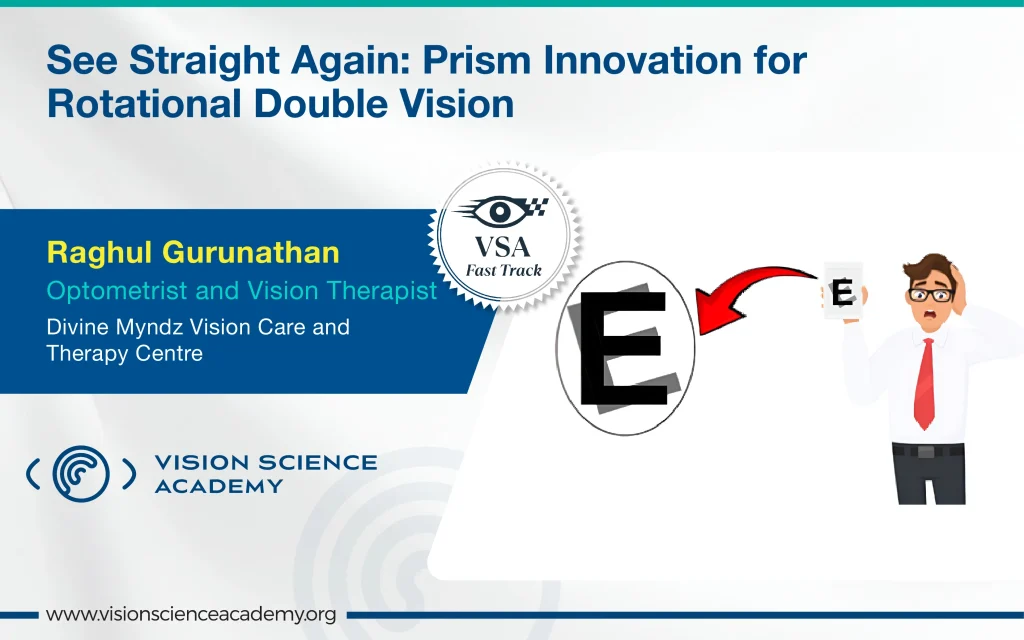Raghul Gurunathan, B. Optom., FBV and VT
Optometrist and Vision Therapist, Divine Myndz Vision Care and Therapy Centre, Chennai, India
Torsional diplopia, or rotational double vision, is a rare yet highly debilitating visual disturbance where one image appears tilted or rotated in relation to the other. Unlike horizontal or vertical deviations, cyclo-deviation involves a twisting misalignment around the visual axis, which interferes with balance, reading, and daily functioning. Traditional prisms, effective for linear misalignments, fail to resolve torsional diplopia, leading to the introduction of a novel cyclo-prism technique. (1)
What Is Cyclo-Deviation?
Cyclo-deviation refers to the rotation of one eye relative to the other around the antero-posterior axis, often leading to a tilted perception of the world. It can result from Traumatic Brain Injury (TBI), vestibular disorders, or idiopathic ocular muscle imbalance. The condition often presents with dizziness, poor spatial orientation, and disturbed visual clarity, particularly in downgaze or when reading small print. (2) Despite its disruptive impact, cyclo-deviation is often underdiagnosed, as patients may struggle to describe the sensation of “tilted” vision. (2)
Limitations of Traditional Prism Therapy
Standard prisms work by bending light in a single plane, either horizontally (base-in/base-out) or vertically (base-up/base-down), effectively aligning the image for conditions like esotropia or hypertropia. However, they are ineffective against rotational misalignments, as they do not rotate the perceived image. (3) As a result, torsional diplopia has historically been managed using occlusion or surgery, with varying success and many limitations. (1)
The Cyclo-Prism Technique
The cyclo-prism is a novel application of standard prism optics to simulate rotational image displacement. The key lies in tilting the prism around its optical axis: typically, 10°-15° to generate a two-dimensional shift that mimics cyclo-rotation. (1)
| Prism Base Direction | Tilt Type | Simulated Rotation |
|---|---|---|
| Base-Out | Retroscopic tilt | Incyclo-rotation (for excyclo) |
| Base-In | Pantoscopic tilt | Incyclo-rotation |
| Base-Down (Temporal) | Temporal tilt outward | Incyclo-rotation |
Figure 1: Left Retro tilt
Figure 2: Left Panto tilt
This technique can be customised based on the direction and degree of torsion. The required effect is fine-tuned using trial lenses in a trial frame, often with temporary Fresnel prisms during assessment. (1)
Clinical Impact
Patients often experience rapid alleviation of tilted vision when the cycloprism is applied. This has a dramatic impact on functional performance in activities of daily living and rehabilitation, especially for individuals with acquired brain injury, where balance and vision are closely linked. (1)
In documented cases, patients with rotational diplopia regained stable, single vision and were able to resume therapy and mobility exercises without discomfort. (1)
Key Benefits
- Non-surgical and customisable: Provides a tailored alternative to surgery with adjustable prism power and orientation. (1)
- Preserves peripheral and binocular vision: Unlike occlusion, it maintains essential peripheral awareness and fusion. (1)
- Improves comfort and outcomes: Enhances visual comfort, stability, and rehabilitation effectiveness. (2)
- Manages cyclo-deviations effectively: Suitable for both unilateral and bilateral torsional misalignments. (3)
Conclusion
Cyclo-deviation presents a complex clinical challenge that standard prisms cannot address. The cyclo-prism technique, by tilting conventional prisms, offers an elegant and effective way to manage torsional diplopia non-invasively. As awareness spreads, it holds promise for improving the quality of life in patients with rotational visual dysfunctions. (1)
References
- Politzer, T., Cilo, M., & Weintraub, A. (2010). A new prism use for treatment of cyclo-deviation in trochlear nerve injury. NeuroRehabilitation, 27(3), 255–259.
- Suchoff, I. B., Kapoor, N., Waxman, R., & Ference, W. (1999). The occurrence of ocular and visual dysfunctions in an acquired brain-injured patient sample. Journal of the American Optometric Association, 70(5), 301–308.
- S.E. Olitsky and L.B. Nelson, (2007) Strabismus Web Book, [ebook] Kansas City: freebookcentre.
